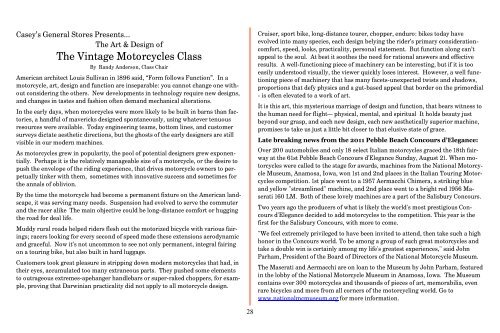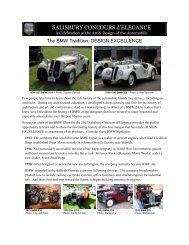The 2011 Salisbury Concours d'Elegance
The 2011 Salisbury Concours d'Elegance
The 2011 Salisbury Concours d'Elegance
Create successful ePaper yourself
Turn your PDF publications into a flip-book with our unique Google optimized e-Paper software.
Casey’s General Stores Presents...<br />
<strong>The</strong> Art & Design of<br />
<strong>The</strong> Vintage Motorcycles Class<br />
By Randy Anderson, Class Chair<br />
American architect Louis Sullivan in 1896 said, “Form follows Function”. In a<br />
motorcycle, art, design and function are inseparable: you cannot change one without<br />
considering the others. New developments in technology require new designs,<br />
and changes in tastes and fashion often demand mechanical alterations.<br />
In the early days, when motorcycles were more likely to be built in barns than factories,<br />
a handful of mavericks designed spontaneously, using whatever tenuous<br />
resources were available. Today engineering teams, bottom lines, and customer<br />
surveys dictate aesthetic directions, but the ghosts of the early designers are still<br />
visible in our modern machines.<br />
As motorcycles grew in popularity, the pool of potential designers grew exponentially.<br />
Perhaps it is the relatively manageable size of a motorcycle, or the desire to<br />
push the envelope of the riding experience, that drives motorcycle owners to perpetually<br />
tinker with them, sometimes with innovative success and sometimes for<br />
the annals of oblivion.<br />
By the time the motorcycle had become a permanent fixture on the American landscape,<br />
it was serving many needs. Suspension had evolved to serve the commuter<br />
and the racer alike <strong>The</strong> main objective could be long-distance comfort or hugging<br />
the road for deal life.<br />
Muddy rural roads helped riders flesh out the motorized bicycle with various fairings;<br />
racers looking for every second of speed made these extensions aerodynamic<br />
and graceful. Now it’s not uncommon to see not only permanent, integral fairing<br />
on a touring bike, but also built in hard luggage.<br />
Customers took great pleasure in stripping down modern motorcycles that had, in<br />
their eyes, accumulated too many extraneous parts. <strong>The</strong>y pushed some elements<br />
to outrageous extremes-apehanger handlebars or super-raked choppers, for example,<br />
proving that Darwinian practicality did not apply to all motorcycle design.<br />
28<br />
Cruiser, sport bike, long-distance tourer, chopper, enduro: bikes today have<br />
evolved into many species, each design belying the rider’s primary considerationcomfort,<br />
speed, looks, practicality, personal statement. But function along can’t<br />
appeal to the soul. At best it soothes the need for rational answers and effective<br />
results. A well-functioning piece of machinery can be interesting, but if it is too<br />
easily understood visually, the viewer quickly loses interest. However, a well functioning<br />
piece of machinery that has many facets-unexpected twists and shadows,<br />
proportions that defy physics and a gut-based appeal that border on the primordial<br />
- is often elevated to a work of art.<br />
It is this art, this mysterious marriage of design and function, that bears witness to<br />
the human need for flight— physical, mental, and spiritual It holds beauty just<br />
beyond our grasp, and each new design, each new aesthetically superior machine,<br />
promises to take us just a little bit closer to that elusive state of grace.<br />
Late breaking news from the <strong>2011</strong> Pebble Beach <strong>Concours</strong> d’Elegance:<br />
Over 200 automobiles and only 18 select Italian motorcycles graced the 18th fairway<br />
at the 61st Pebble Beach <strong>Concours</strong> <strong>d'Elegance</strong> Sunday, August 21. When motorcycles<br />
were called to the stage for awards, machines from the National Motorcycle<br />
Museum, Anamosa, Iowa, won 1st and 2nd places in the Italian Touring Motorcycles<br />
competition. 1st place went to a 1957 Aermacchi Chimera, a striking blue<br />
and yellow "streamlined" machine, and 2nd place went to a bright red 1956 Maserati<br />
160 LM. Both of these lovely machines are a part of the <strong>Salisbury</strong> <strong>Concours</strong>.<br />
Two years ago the producers of what is likely the world's most prestigious <strong>Concours</strong><br />
<strong>d'Elegance</strong> decided to add motorcycles to the competition. This year is the<br />
first for the <strong>Salisbury</strong> <strong>Concours</strong>, with more to come.<br />
"We feel extremely privileged to have been invited to attend, then take such a high<br />
honor in the <strong>Concours</strong> world. To be among a group of such great motorcycles and<br />
take a double win is certainly among my life's greatest experiences," said John<br />
Parham, President of the Board of Directors of the National Motorcycle Museum.<br />
<strong>The</strong> Maserati and Aermacchi are on loan to the Museum by John Parham, featured<br />
in the lobby of the National Motorcycle Museum in Anamosa, Iowa. <strong>The</strong> Museum<br />
contains over 300 motorcycles and thousands of pieces of art, memorabilia, even<br />
rare bicycles and more from all corners of the motorcycling world. Go to<br />
www.nationalmcmuseum.org for more information.




